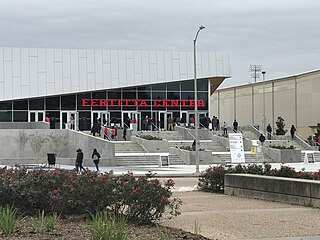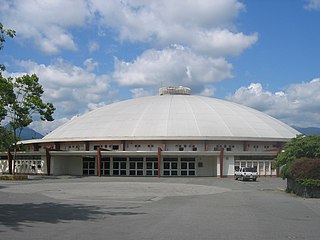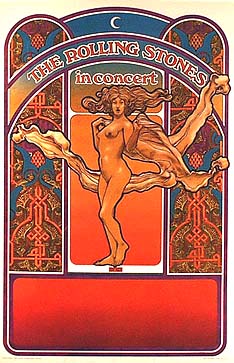
Sam Houston Coliseum was an indoor arena located in Houston, Texas.

Sam Houston Coliseum was an indoor arena located in Houston, Texas.
Located at 801 Bagby Street in Downtown Houston, the Coliseum and Music Hall complex replaced the Sam Houston Hall, which was a wooden structure that had been erected on the site for the 1928 Democratic National Convention and torn down in 1936. [1] The Public Works Administration contributed $1,329,508 to the project designed by architect Alfred C. Finn. Groundbreaking ceremonies were held on November 4, 1936. [2] The arena opened in November 1937 and had a capacity of 9,200. It was built in conjunction with the Houston Music Hall, which was adjacent to the Coliseum.
On October 14, 1956, Elvis Presley's concert at the Coliseum ended abruptly, as he and his band were taken away by police escort, just before the end of the show as a mob of about 1,000 teenagers rushed the stage, their instruments being destroyed as a result.
On November 21, 1963, United States President John F. Kennedy gave a speech in the Houston Coliseum, on what would be the last night of his life. John F. Kennedy was assassinated in Dallas the following day.
On August 19, 1965, The Beatles performed at the Coliseum.
On August 20, 1967, James Brown performed at the Coliseum.
On July 10, 1968, The Doors performed at the Coliseum with the opening band Moving Sidewalks, featuring Billy Gibbons who would go on to form ZZ Top less than a year later.
Supergroup Cream played there on October 24, 1968. [3]
Jimi Hendrix played at the venue on June 6, 1970, three months before he died.
Ike & Tina Turner performed at the Coliseum on July 31, 1971. [4]
Trapeze (band) performed at the Colisseum on Saturday, October 21, 1972. The show was recorded and released as a double live album in 2021 called "Trapeze Live in Houston 1972."
Bruce Springsteen & the E Street Band played here November 9, 1974, and again on September 13 and 14, 1975.
The First National Women's Conference, a milestone for the modern women's movement, was held at the Coliseum in November 1977.
Ozzy Osbourne with Randy Rhoads played at the venue on June 7, 1981, and February 17, 1982.
Stevie Ray Vaughan with Double Trouble (band) performed at the venue on November 24, 1989, on his last tour before Vaughan's tragic death in a helicopter crash nine months later.
Ice Cube and Too Short bought their Straight From The Underground Tour to Sam Houston on December 23, 1990, with Yo-Yo, D-Nice, Kid Rock, Poor Righteous Teachers, and King T.
The Black Crowes played a free concert at the venue on February 6, 1993. The free show was due to security problems that forced the cancellation of a show during a previous Houston visit. The show was broadcast nationally on radio across North America and also was videotaped for the video "Bad Luck Blue Eyes Goodbye". The audio version was released on EPs, dubbed "High in Houston". This would be the last concert performed at the Coliseum before it was demolished.
In 1946, permanent ice chillers were installed in the floor to accommodate an ice hockey rink for Houston's first pro ice hockey team – the Houston Skippers of the USHL. The Skippers changed their name the following season to the Houston Huskies and called the Coliseum home until their demise in 1949.
Prior to Hofheinz Pavilion being built (on the campus of the University of Houston), the Houston Cougars played home games at the coliseum. [5]
The venue also played host to the Houston Apollos, of the CPHL, from 1965 to 1969; the Houston Aeros, of the WHA, from 1972 to 1975 and the Houston Apollos of the CHL, from 1979 to 1981. The Aeros moved to The Houston Summit, which opened in November 1975 and played their final three seasons there.
The Houston Mavericks, a charter member of the American Basketball Association, played their home games in the Coliseum. However, the Houston franchise was plagued by mismanagement and low attendance. In 1969, the team relocated and became the Carolina Cougars. The Mavericks drew less than 500 fans for most games; their final game in Houston drew just 89 fans. [6]
The Coliseum was also home to Houston Wrestling, run by legendary wrestling promoter Paul Boesch. In an event promoted by Boesch, Jack Brisco defeated Harley Race to win the National Wrestling Alliance World Heavyweight Championship at the Coliseum on July 20, 1973.
Before moving to the Astrodome, it was the home of the Houston Livestock Show and Rodeo.
By the 1970s, the arena was starting to show its age. Its fate was effectively sealed in 1971, when the NBA's San Diego Rockets moved to Houston and insisted on building a new arena—what became the Summit—as a replacement. When the Rockets arrived, they would not even consider playing in the Coliseum while the Summit was being built, deeming it inadequate even for temporary use; instead, they played their first few seasons at Hofheinz Pavilion.
Sam Houston Coliseum was demolished in 1998. [1] The former site of the Sam Houston Coliseum was redeveloped into the Hobby Center for the Performing Arts, which opened in 2003.

The Lakewood Church Central Campus is the main facility of Lakewood Church, a megachurch in Houston, Texas, five miles southwest of Downtown Houston and next to Greenway Plaza.

Wembley Arena is an indoor arena next to Wembley Stadium in Wembley, London, England. The 12,500-seat facility is London's second-largest indoor arena after The O2 Arena, and the ninth-largest in the United Kingdom.

Chicago Coliseum was the name applied to three large indoor arenas, which stood at various times in Chicago, Illinois, from the 1860s to 1982. They served as venues for large national conventions, exhibition halls, sports events, and entertainment.

The Greensboro Coliseum Complex, commonly referred to as Greensboro Coliseum, is an entertainment and sports complex located in Greensboro, North Carolina. Opened in 1959, the complex holds eight venues that includes an amphitheater, arena, aquatic center, banquet hall, convention center, museum, theatre, and an indoor pavilion. It is the home of the UNC Greensboro Spartans men's basketball team, the Greensboro Swarm of the NBA G League, the Carolina Cobras of the National Arena League, as well as the Atlantic Coast Conference (ACC) with their Men's and Women's basketball tournaments.

Omni Coliseum was an indoor arena in Atlanta, Georgia, United States. Completed in 1972, the arena seated 16,378 for basketball and 15,278 for hockey. It was part of the Omni Complex, now known as the CNN Center.

Pacific Coliseum, known to locals as "The Coliseum" or the "Rink on Renfrew," is an indoor arena located at Hastings Park in Vancouver, British Columbia. Its main use has been for ice hockey and the arena has been the home for several ice hockey teams.

Reunion Arena was an indoor arena located in the Reunion district of downtown Dallas, Texas, United States. The arena served as the primary home of the National Hockey League's Dallas Stars and the National Basketball Association's Dallas Mavericks. The venue's capacity held accommodations for 17,000 for ice hockey spectators, and 18,190 for basketball spectators.

The International Amphitheatre was an indoor arena located in Chicago, Illinois, that opened in 1934 and was demolished in 1999. It was located on the west side of Halsted Street, at 42nd Street, on the city's south side, in the Canaryville neighborhood, adjacent to the Union Stock Yards.

Allstate Arena is a multi-purpose arena in Rosemont, Illinois, United States, northwest of Chicago, located at the corner of Mannheim Road and Lunt Avenue, just north of Mannheim Road's interchange with the Jane Addams Memorial Tollway (I-90) about 3 miles (4.8 km) north of O'Hare International Airport. The facility opened in 1980 as the Rosemont Horizon and seats 17,500 for basketball and 16,692 for ice hockey.

Bojangles Coliseum is an 8,600-seat multi-purpose arena located in Charlotte, North Carolina. It is operated by the Charlotte Regional Visitors Authority, which also oversees nearby Ovens Auditorium and the uptown Charlotte Convention Center. The naming-rights sponsor is the Bojangles restaurant chain. The building's signature domed roof is made of tin, rather than steel or iron. The dome spans 332 feet in diameter and rises to 112 feet tall.

The Indiana Farmers Coliseum is a 6,500-seat indoor multi-use arena, located on the Indiana State Fairgrounds in Indianapolis. The Indiana Farmers Coliseum is home to both the Indy Fuel of the ECHL and the IUPUI Jaguars of the NCAA.

The Fertitta Center, formerly known as Hofheinz Pavilion, is a 7,100-seat multi-purpose arena on the University of Houston campus in Houston. Located at 3875 Holman Street, it is home to the Houston Cougars men's and women's basketball teams and the women's volleyball team. The arena opened in 1967 as Hofheinz Pavilion, named after Roy Hofheinz and his late wife, Irene Cafcalas "Dene" Hofheinz, after they donated $1.5 million to help fund construction. Roy Hofheinz, known as Judge Hofheinz, was a UH alumnus and a Houston politician, businessman, and philanthropist. The arena is now named after restaurant magnate, Houston Rockets owner and UH alum Tilman Fertitta, who donated $20 million toward the complete renovation of the arena in 2016. The court is named for Hall of Fame and former Cougars coach Guy V. Lewis. The arena also contains an alcove dedicated to Basketball Hall of Famer Elvin Hayes, a Cougar player in the 1960s and NBA star in the 1970s. Like many arenas of its kind, the seating bowl of Fertitta Center is dug into the ground so that one enters the building at the top of the bowl.

Hampton Coliseum is a multi-purpose arena in Hampton, Virginia. Construction began on May 24, 1968. The venue held its first event on December 1, 1969, with the nearby College of William & Mary playing North Carolina State University in a college men's basketball game. On January 31, 1970, the Coliseum formally opened as the first large multi-purpose arena in the Hampton Roads region and the state of Virginia

The Jacksonville Veterans Memorial Coliseum was a multi-purpose arena located in Jacksonville, Florida. Built in 1960 and known as "northern Florida's most historic concert venue", it was home to most of the city's indoor professional sports teams and it hosted various concerts, circuses, and other events. It was demolished in 2003 and replaced with the VyStar Veterans Memorial Arena.

Hirsch Memorial Coliseum is 10,000-seat multi-purpose arena in Shreveport, Louisiana, designed by the late local architect Edward F. Neild Jr. (1908–1958) who, with his father in 1937, had designed the Louisiana State Exhibit Museum in Shreveport. The coliseum is named after William Rex Hirsch, a former fair president, manager and treasurer. The building completed construction in 1954, the year of Hirsch's death, and initially was planned to have the name The Youth Building. The coliseum has been used for a variety of events through the years, with dirt being brought in and placed on the floor for rodeos and tractor pulls. It is located adjacent to the Independence Stadium and across from Fair Park High School in Shreveport. Hirsch coliseum is very similar in design, though smaller in size to the John M. Parker Agricultural Coliseum, owned and operated by the Louisiana State University Campus in Baton Rouge. However, the Parker coliseum has a dirt floor arena and is mainly used for livestock-type events, with portable hard floors laid on top of the dirt for other types of events such as basketball games or concerts.

J. S. Dorton Arena is a 7,610-seat multi-purpose arena located in Raleigh, North Carolina, on the grounds of the North Carolina State Fair. It opened in 1952.

Denver Coliseum is an indoor arena, owned by the City and County of Denver, operated by its Denver Arts & Venues and located in Denver, Colorado. The arena holds 10,200 people and was built from 1949 to 1951. The coliseum is located in Denver's Elyria-Swansea neighborhood. It sits where the Denver Pacific Railway broke ground on its Cheyenne line in 1868.

Oslo Spektrum is a multi-purpose indoor arena located in east central Oslo, Norway, that opened in December 1990. It is currently owned and operated by Nova Spektrum, formerly Norges Varemesse. Oslo Spektrum is primarily known for hosting major events such as the annual Nobel Peace Prize Concert, the Eurovision Song Contest 1996, and concerts by artists of national and international fame.

PNE Agrodome is a sports arena located in Vancouver, British Columbia. It was built in 1963 and holds 5,000 people or 3,260 when configured to use the hockey or lacrosse surface.

The Rolling Stones' 1969 Tour of the United States took place in November 1969. With Ike & Tina Turner, Terry Reid, and B.B. King as the supporting acts, rock critic Robert Christgau called it "history's first mythic rock and roll tour", while rock critic Dave Marsh wrote that the tour was "part of rock and roll legend" and one of the "benchmarks of an era." In 2017, Rolling Stone magazine ranked the tour among The 50 Greatest Concerts of the Last 50 Years.